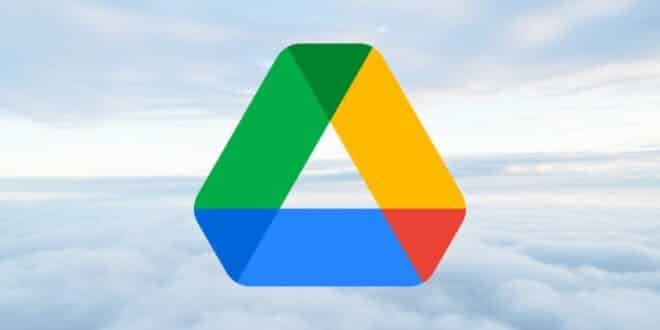Sure! Here’s the rewritten article with title capitalization applied only to the first word:
Google Drive is the cloud service from Google, accessible to anyone with a Google account. It allows users to store data online to free up space on their computers.
If you have a Google account, you have access to its cloud service, Google Drive. This provides access to several related services such as Google Docs for word processing and Google Sheets for spreadsheets. In this article, you will learn how Google Drive works and how to use it.
Google Drive, a one-stop cloud service
The use of Google Drive has been around for several years now. It was launched in April 2012 to allow Google users to store and synchronize data online.
It also provides the opportunity to share documents of all kinds and edit them at will via the Internet, on Google’s servers.
Today, Google Drive is available in web version for Windows and macOS, and in mobile version for iOS and Android. With such a tool, Google seems to enhance its users’ online collaboration.
The cloud is used by both individuals and businesses. This service helps free up hard drives of computers and mobile devices to install larger software or applications.
How Google Drive Works
As mentioned above, Google Drive allows users to store and synchronize files with a computer. All modifications to documents can be made online, via the Drive website or its mobile app.
The synchronization becomes permanent once its client software is installed on the computer. This allows you to update your files at any time.
Moreover, Google’s office tools are available on Google Drive including Google Docs, Google Sheets, and Google Slides. Additionally, sharing can be customized.
Besides sharing, Google Drive also offers the possibility to customize file editing. This means that the owner can set who can access and modify your data online.
With Drive, Google Workspace allows up to 100 people to edit documents. Workspace is the new name given to the entire Google suite since October 2020.
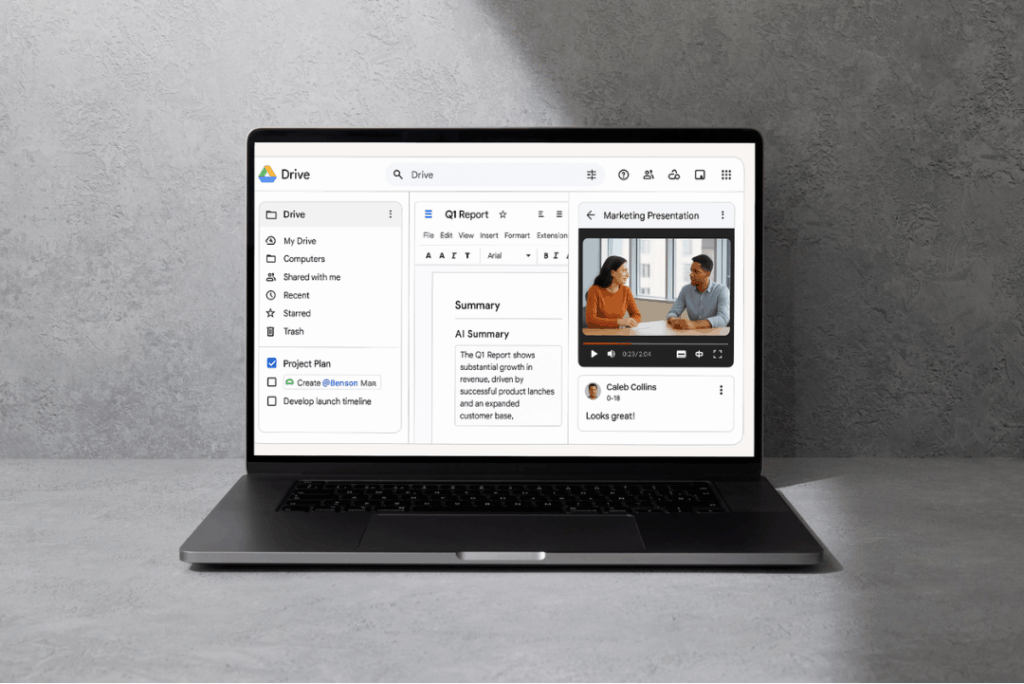
Google Drive Steps Up in 2025
Artificial Intelligence Transforms Your Drive
Since 2024, Google Drive has gradually integrated Gemini (formerly Bard) into the Workspace environment. This evolution allows for automatically summarizing the content of compatible files directly from the Docs or Drive interface, making it easier to identify key elements without opening each document.
Gemini can also generate content in Google Docs, based on user needs. It provides paragraphs, titles, or formulations tailored to the document’s context.
Finally, search in Drive has been enhanced with contextual AI. It now considers user intent rather than just keywords, making it easier to quickly access the right documents.
Docs and Sheets Become Interactive with Smart Canvas
Google Drive now relies on Smart Canvas, a collaborative interface integrated with Docs and Sheets. This system introduces Smart Chips, interactive elements triggered by @mentions, allowing for the integration of contacts, files, or events directly into the document.
Users also have access to dynamic checklists, interactive blocks, and modular templates, facilitating project structuring. This approach transforms traditional files into true evolving workspaces, connected to the rest of the Workspace environment.
Enhanced Collaboration: Video, Audio, and Media at the Heart of Drive
Google Drive is evolving into a multimodal collaboration center, integrating new ways to interact around files. It is now possible to collaborate in embedded audio or video streams, notably via Meet or directly from the overview of a shared document.
Multimedia documents also benefit from rich previews, with integrated playback, possible annotations, and real-time comment options. These innovations strengthen Drive’s collaborative use, going beyond text by adapting to various formats such as video, audio, or interactive presentations.
Benefits of Google Drive for Businesses
Google Drive is not just for individuals; it is also a powerful tool for businesses. Thanks to its cloud infrastructure, Drive facilitates the management and organization of large amounts of files, improving document search efficiency within organizations.
Optimization of Document Management by AI
One of the major challenges for businesses is managing a large volume of data. Google Drive addresses this challenge by incorporating advanced artificial intelligence (AI) and machine learning (ML) models. The highly appreciated “Priority” feature analyzes document activity and assigns priority based on their use. The more a file is modified or shared, the more easily it will be accessible in this priority space.
This AI also suggests proactive actions, such as responding to comments or approving access requests, making collaboration smoother and more responsive.
Improved Collaboration and Real-Time Tracking
Google Drive allows real-time collaboration with up to 100 simultaneous users through Google Workspace. Whether modifying a document, adding comments, or tracking changes, everything is synchronized instantly. Every modification or interaction is clearly indicated, allowing teams to stay aligned on updates.
In 2025, users can leverage Canvas, an interactive space that allows for co-creating and refining text or code content with AI before exporting it to Docs.
Another innovation, Audio Overviews, automatically transforms documents or notes into audio CVs, available in multiple languages, facilitating mobile reading or multitasking. All these features offer a more dynamic and proactive approach to collaborative work, transforming Drive into a true intelligent content production center. These tools are accessible without leaving the Drive environment, enhancing the experience without requiring external applications.
The Gemini 2.5 family (Flash, Flash-Lite, Pro) was launched in general availability in 2025. It offers multimodal capabilities (text/images/audio), broader context, and improved reasoning before responding.
Gemini can now:
- Automatically summarize PDFs, forms (Google Forms responses), or videos stored in Drive.
- Perform tasks through natural language in Drive: move files, organize folders, create documents from prompts.
- Manage multimodal inputs: images, videos, audio in addition to text, allowing interaction with various content in Drive/Docs.
The “Agent Mode” feature was announced in 2025 for Gemini, allowing the AI to take over autonomous actions (scheduling, task management), not just responding.
Enhanced Privacy and Security
Another significant advantage for businesses is the data privacy. Google Drive uses internal signals only to enhance user experience through suggestions and prioritizations, without sharing them with third parties or even IT administrators. Furthermore, files are protected by advanced AES-256 encryption, ensuring optimal security for sensitive information.

How to Use Google Drive
To benefit from Google Drive’s cloud computing service, you need to create a Gmail account, which is Google’s email service. Note that those who already have an account can access Drive.
Once the account is created, you can access all the services of Drive. The web version is the most commonly used, available for computers. However, there is also a mobile version.
To enjoy the backup service on your computer, simply download the “Backup and Sync from Google” service.
Here’s how each version of Drive works along with third-party applications:
The Web Interface
To access Google Drive on your browser, go to drive.google.com and log in with your Gmail account. Google Drive has different tabs, here are the main ones:
The Drive tabs are available on the left side of your screen. These tabs serve to organize your files by category.
In addition, you can access all your Drive files in the “My Drive” tab. This tab also houses the Drive folder on your computer when it is synchronized.
The other synchronized data from your hard drive can be accessed in the “computers” tab. As for “shared with me,” this option contains all the folders shared with you by your contacts.
Of course, these are not the only tabs; there are many others. You will see them as you use Drive on your computer.

The Mobile Version
You can always use your mobile device, smartphone, tablet, to work with your files on the cloud. Whether your device runs on Android or iOS, you can download the Google Drive app from Google Play or the App Store.
The tabs are fairly similar to those in the web version. A “plus” button allows you to upload files, create a new folder, or scan a document.
OS Compatibility
Google Drive offers software compatible with Mac (macOS) and Windows. A mobile version for both Android and iOS is also available. For iOS, the 11.0 version is accessible from iPad, iPhone, and iPod touch. Importantly, Google Drive can operate on any platform. Consequently, it is possible to access its service online from any web browser and any operating system (Linux, Mac, Windows).
How to Transfer Data to Google Drive

To do this, you need to use the services offered by Google Drive. Generally, you need to import the file using the “+New” button in Google Drive. Then, select the “Upload files” option that appears in the side menu. Locate the file to be imported and wait for the process to complete.
However, there is a simpler solution: drag and drop the file. For this to work, you must locate the target file and bring it to the forefront on your computer screen.
Document Sharing
The main functions of Drive are data sharing and synchronization. There are two sharing options. The first is done by sharing the link generated by the document on the cloud, this option is called “Get Link.” To do this, click on the document.
The second sharing option is called “Share.” It opens a dialog box where you can add other people who can have access to the selected document. In this case, adding a person in the dialog box means granting them permission either to view the document or to edit it. For this, the added person must have their own Gmail account.
Synchronization with Your Desktop
Google Drive can also be synchronized with your desktop through the “Backup and Sync from Google” application.
Its installation automatically creates a Drive folder on your computer. All files in this folder are automatically uploaded to Drive. You can also choose other folders to synchronize.
All files on the cloud are updated as you modify them. You can change your preferences at any time or disable synchronization. In this case, the update will be disabled.
If you download the application on multiple computers, Google Drive will synchronize the same folders on all devices connected with the same account.
Third-Party Google Drive Applications
In addition to sharing and synchronizing data, Google Drive also allows access to various applications available on a virtual marketplace. The marketplace is none other than the Google Workspace Marketplace.
The Marketplace offers a plethora of third-party applications with which you can preview or open multiple types of files.
Using an application requires its installation on your device. However, you can still use a third-party application to open a file by right-clicking on the file, selecting “open with,” and then selecting “connect more applications.”
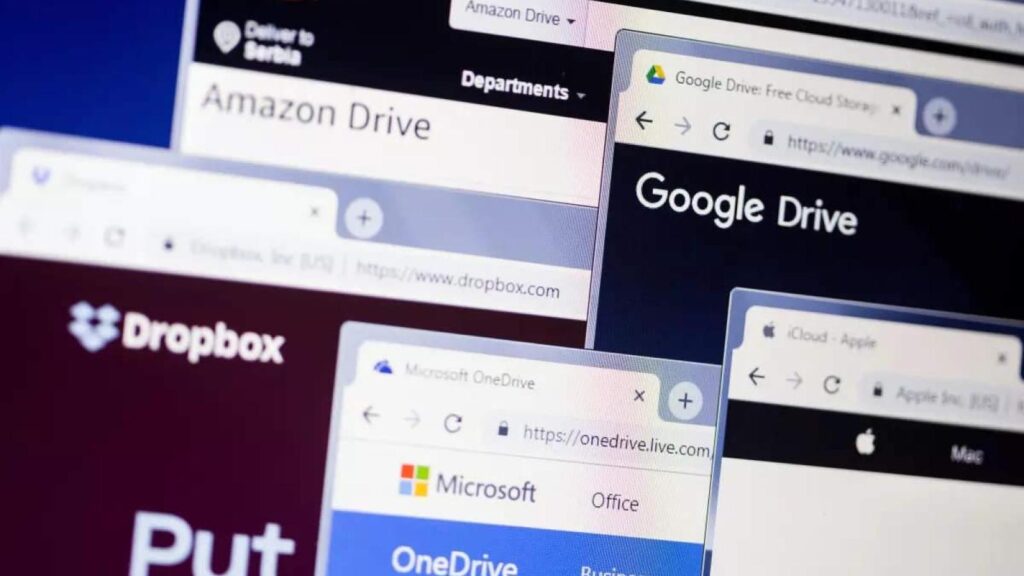
The Disadvantages of Google Drive
Although Google Drive remains one of the powerful storage tools with many advantages, it has some drawbacks.
Security Risks
The most significant drawback of using Google Drive is that hackers can delete essential data. They do so by installing malicious hardware on the server. Consequently, files disappear. The password feature can be hacked. Thus, one of the persons with whom the link was shared may pass it on to others.
This is a considerable risk, especially if documents shared with business partners are sensitive, such as financial statements. If a third party gains access, they could harm the business.
Requires an Internet Connection
To access Google Drive, you need an Internet connection. You can work offline, but modifications and comments made are only visible once the connection is established. This is a significant drawback, as it is impossible to work in remote areas without Internet.
File Upload is Limited to a Certain Size per Day
Google Drive cannot upload files larger than 5 TB per day. This is equivalent to 1000 GB and limits most users who work daily with large files. Once the limit is reached, the upload automatically stops, and you must wait until the next day to recover more.
Erratic Third-Party Applications
Several add-ons and applications work seamlessly with Google Drive. Mainly third-party applications, which integrate easily with this platform. However, some third-party applications require payment to unlock their features.
Upload and Download Speed
When downloading files from Google Drive, the speed can become slow. With millions of people using the platform simultaneously, this should be expected.
Additionally, Google Drive is relatively new, and the company may not have considered speed. It may improve or degrade over time as the number of users increases.
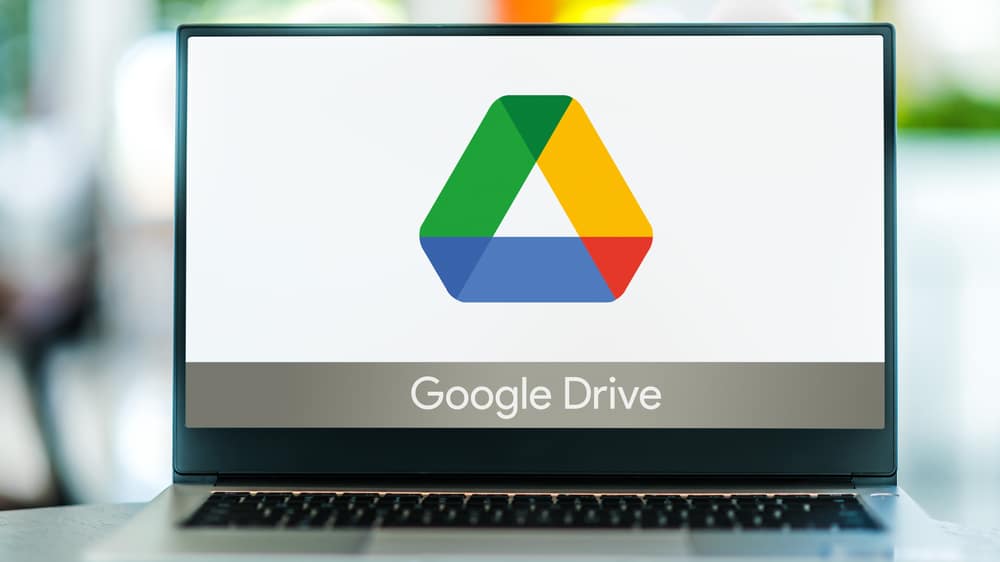
How to Recover Deleted Files on Google Drive?
There are several methods to recover deleted files on Google Drive, which primarily fall into two scenarios.
1. Recovery via the Google Drive Trash
When you delete a file in Google Drive, it is automatically moved to the trash. As long as the trash is not emptied, you can restore files easily with a few clicks:
- Deletion Tooltip: After deleting a file, a tooltip appears in Google Drive, offering the option to undo the action immediately. This option allows you to return the deleted file to its original location with one click.
- Manual Restoration from Trash: If the tooltip has disappeared or you need to recover a deleted file later, go to your trash in Google Drive, select the concerned file, and then click on “Restore” to send it back to its original location.
It is important to note that files remain in the trash for 30 days. After this period, they are permanently deleted and can no longer be restored directly from the trash.
2. Recovery of Permanently Deleted Files
If the files have been deleted from the trash after the 30-day period or manually, there are still two solutions to attempt to recover them:
- Recovery from a Backup: If you have set up external backups or are using a service like Google Vault (reserved for professional users), it is possible to restore permanently deleted files from these sources.
- Recovery via the Google Workspace Admin Console (formerly G Suite): If you are an administrator of a Google Workspace account, you can restore files for your users within 25 days of their permanent deletion. Here’s how to do it:
- Log in to the Google Admin Console.
- In the Users section, select the concerned user.
- Click on More (or the three dots) next to the user, then select Restore Data.
- In the restore window, choose the date range corresponding to the deletion period (up to 25 days) and click Restore.
These options allow you to effectively recover your files, even if they were deleted permanently.
The Prices of Google Drive
Google Drive is a popular online storage solution, offering a variety of plans to meet the needs of individual users and businesses. In 2024, Google Drive’s pricing breaks down as follows:
Plans for Individual Users
15 GB: Free
Google offers 15 GB of free storage for each Google account. This space covers Drive, Gmail, and Google Photos, providing sufficient basic storage for most casual users.
100 GB: €1.99/month
For those needing a bit more space, the 100 GB plan at €1.99/month is a very affordable option. Ideal for storing additional files without breaking the bank.
1 TB: €9.99/month
The 1 TB plan for €9.99/month is perfect for those storing numerous large files, such as videos or work projects.
10 TB: €99.99/month
For even greater storage, the 10 TB plan is available at €99.99/month. Suitable for professionals or creatives handling enormous quantities of data.
20 TB: €199.99/month
The 20 TB plan costing €199.99/month is designed for users with massive storage needs, like companies with numerous documents or digital archives.
30 TB: €299.99/month
Finally, the 30 TB plan at €299.99/month is the ultimate option for those requiring an exceptional amount of storage.
Plans for Businesses (Google Workspace)
Business Starter: €6/user/month
This plan includes 30 GB of storage per user. It is ideal for small businesses looking for a shared storage solution at a reasonable price.
Business Standard: €12/user/month
For businesses needing more space and features, the Business Standard plan offers a comprehensive solution at €12/user/month.
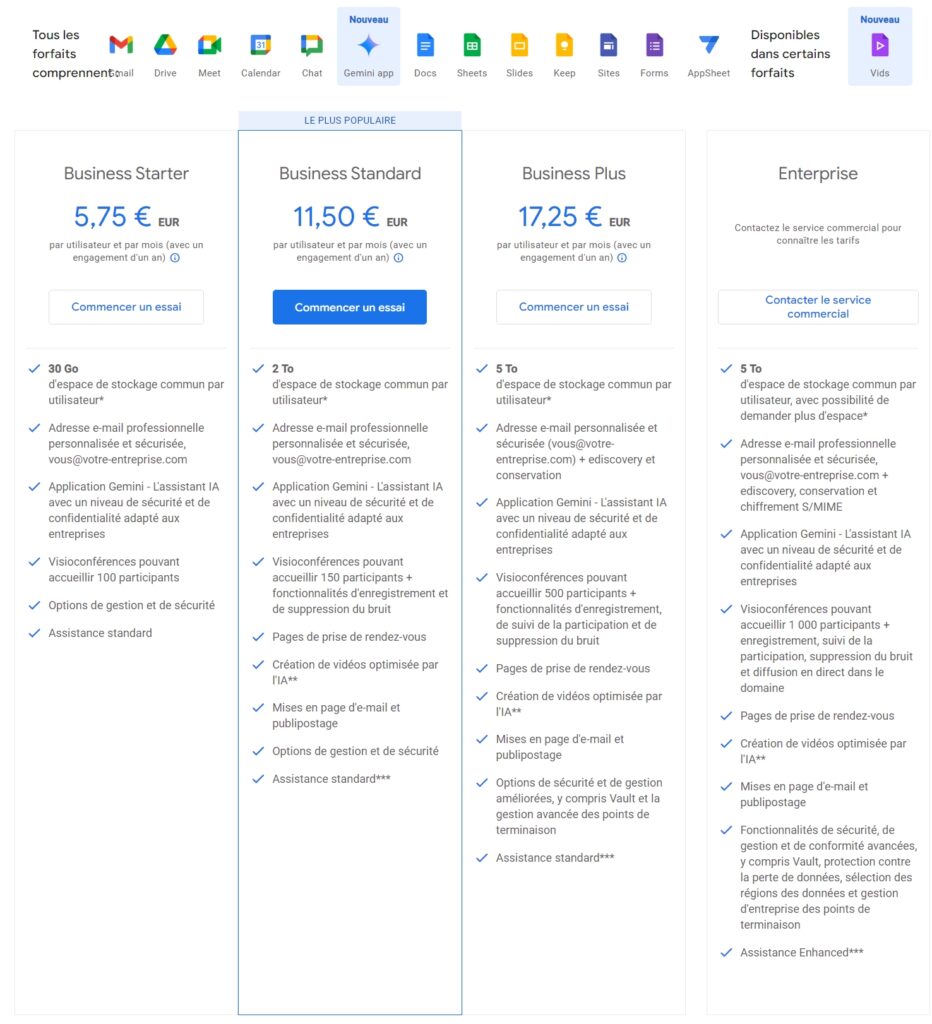
Is Google Drive Completely Secure?
Google Drive always employs robust security protocols, such as AES 256-bit encryption for data at rest and TLS/SSL for data in transit. However, security also relies on user practices. The data is encrypted during transfer (TLS/SSL) and at rest on Google’s servers (AES 256-bit). Phishing attacks remain a significant threat. Multifactor authentication (MFA) is essential.
Sharing files with overly permissive options (such as “Anyone with the link”) can also expose sensitive data. It is recommended to implement strict access controls.
Furthermore, third-party applications integrated with Google Drive may request excessive permissions or be malicious. Regular audits of application permissions are advisable.
It is crucial to revoke access for former employees or collaborators to prevent data leaks. As of April 2025, Google Drive still does not provide a native feature to password protect folders. Security relies on sharing permissions. An alternative solution is to compress and encrypt folders before uploading them.
Google encrypts your data but does not offer zero-knowledge encryption by default, meaning Google holds the encryption keys to your data.
How to Secure Google Drive?

Most Google users have fallen victim to hacks. In fact, around 5 million Gmail passwords and credentials were stolen in 2014 and leaked online. So, Google Drive users undoubtedly wonder how secure their files really are.
It is important to note that often, the greatest risk to data lies with the user themselves and the computers or devices used to connect to Google Drive. Files stored on Google Drive sync with computers, making them vulnerable. To mitigate this, it is advisable to use encryption to better hide and protect your files.
Additionally, you should take advantage of two-factor authentication to prevent hackers from accessing files from another device, even if they have taken possession of the credentials. And of course, always ensure to have a strong password.
It is also wise to “remove all apps or browser extensions that have unnecessary access to Google Drive.” Every application with permission to access Google Drive poses an additional vector for hackers and a security flaw.
Despite past hacks, the risk associated with using Google Drive remains low. Google employs strong AES 256-bit encryption on all its servers. Similarly, when data transfers between users and these servers, Google uses the TLS protocol to secure the data and prevent interception.
How to Free Up Storage Space on Google Drive?
Google Drive provides 15 GB of storage, but it can be easy to reach the limit. To increase it, there are two possibilities, including subscribing to a paid plan or cleaning up files.
Do not want to spend more? Here are some simple methods:
First, check for the largest files stored in the cloud.
To do this, visit https://drive.google.com/drive/quota. This portal lists all folders based on size. From this page, simply identify which large files to delete.
Google Drive works like a computer and has a recycle bin. Although after 30 days, its content is automatically deleted, it is better to clear it to gain maximum space.
Additionally, cleaning up Google Photos and Gmail is also advisable. In fact, the 15 GB offered by Google is shared between Gmail and Google Photos. Deleting some large files on these services also helps free up some space.
Compressing photos uploaded to Google Photos also helps optimize storage capacity on Google Drive, even though this could reduce image quality.
How to Disable Google Drive on Android?

Connecting to Google Drive from a computer or mobile device is permanent. To disconnect it on an Android device, the user needs to remove their Google account from it.
To begin, go to Settings and click on Accounts.
Next, select Google to remove the existing account.
After this step, click on More, a section found at the upper right corner. This action redirects the user to the Delete Account option. Then, simply confirm by clicking the designated button.
Disconnect on PC and Mac
To disconnect from the Google Drive application, simply click from Google on the “Backup and Sync” icon. This icon is located in the notification area of Windows, at the lower right corner of the screen. For Mac users, this button appears at the top of the screen.
When the Google Drive panel opens, click on the three little dots in the menu and choose Preferences. In this window, go to the Google Drive section on the left. After that, uncheck the “Sync My Device” category.
The Process
To completely remove the Google Drive account from the current workstation, go to the Settings tab.
Next, press Disconnect My Account to log out of Google Drive on this device. To validate these actions, simply click on Quit Backup and Sync. This operation will disable Google Drive.
How to Uninstall Google Drive from Your Computer?
Uninstall Google Drive from Windows
First, you should launch Google Drive if it’s not already running. Then, the user must click on the Google Drive icon in the taskbar and select Preferences.
Once the Google Drive preferences window appears, the user needs to click on “Disconnect Account,” then click Yes to confirm the disconnection. After a few seconds, the account will be disconnected, and the user should click OK when the verification message appears. Next, go to Control Panel >> Programs and Features and uninstall Google Drive.
How to Uninstall Google Drive from Mac?
Regardless of the application being uninstalled, you must first end all associated processes. To uninstall Google Drive, you need to disconnect from your account, then quit it. To do this, navigate to Google Drive -> Preferences in the menu bar. Next, click “Disconnect Account” in the preferences panel.
Disconnecting the account completely stops synchronization and allows you to log out of your Google account later. Then go to Google Drive -> Exit Backup and Sync to quit Google Drive running in the background.
Additionally, you can use the Activity Monitor to terminate all associated processes with Google Drive. This system can force any process to stop as soon as you decide to end it. The uninstallation can be initiated now. To do so, simply drag Google Drive, located in the Applications folder, into the Trash.
Comparison: Google Drive vs. Its Competitors
| Service | Strengths | Limitations |
|---|---|---|
| Dropbox | Easy sharing, versioning | Less free space (2 GB) |
| OneDrive | Integration with Microsoft Office | Less intuitive for non-users |
| pCloud | Enhanced security | Limited features in free version |
| Tresorit | End-to-end encryption | Higher pricing |
Google Drive in 2025: Is It Still an Essential Tool?
In 2025, Google Drive remains one of the most popular online storage services, thanks to its ease of use and perfect integration with Google Workspace. With 15 GB of free storage, it meets the needs of both individuals and professionals looking to centralize their files and collaborate easily.
The basic features, like automatic backup and file synchronization, make its use intuitive. Google Drive also comes with very handy tools like Google Docs, Sheets, and Slides, which allow simultaneous online work with multiple users. These tools make Google Drive a valuable ally for teams looking to boost their efficiency, even remotely.
Despite this, some weaknesses remain. The interface, although fairly user-friendly, can sometimes seem unintuitive for certain users, particularly beginners. In terms of security, the lack of end-to-end encryption impacts our assessment of Google Drive. Nevertheless, Google Drive already offers numerous technical features and services at an affordable price.
What Are the Advantages of Google Drive in 2025?
The most significant benefit of having all your digital resources in the cloud lies in the ability to access them from anywhere. The only prerequisite is authenticating to Google Drive using your Google credentials on the electronic device of your choice.
This flexibility allows you to conduct your professional or personal activities wherever you are. It also helps completely eliminate the need to physically transport your documents on external drives such as USB sticks or external hard drives.
This feature is especially valuable during professional situations requiring impromptu presentations in meeting contexts. However, it is advisable to remain vigilant and systematically log out of your account when using shared or non-personal equipment.
The synchronization feature is a natural extension of this mobility offered by Google Drive. Its main appeal lies in its ability to keep your documents perfectly synchronized across various devices through Internet connectivity. This platform also allows you to automatically upload files from your personal computer, smartphone, or any compatible peripheral to your Google Drive storage space.
FAQ
Google Drive is an online storage service developed by Google. This platform allows users to save files in the cloud, synchronize them between different devices, and collaborate on documents. Each Google account receives 15 GB of free space, shared with Gmail and Google Photos.

